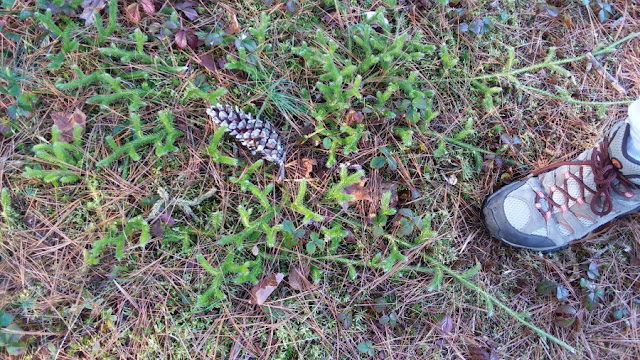Well, it had to happen sometime. The nice da capo back to early fall was great while it lasted, but alas, reality has returned. I even had to change the journal banner photo from fall foliage to November drab. But wasn't that warm, calm, summer reprieve wonderful?
One benefit of drab November with no leaves on the trees is improved visibility through the forest and all the sights that become newly available. Linda took advantage of that one morning when she spotted a barred owl that might have been hidden from sight a few weeks ago.
 |
| A barred owl watches me carefully. |
I didn't realize it actually had its back to us until it turned its head around.
 |
| Now it's facing forward. |
That neck rotation always amazes me. I'll bet the owls also appreciate the better sight lines when spinning their heads around in search of prey.
This particular bird was being harassed by a flock of blue jays which were scolding loudly, encouraging it to move along, and it did so, flying a few dozen yards at a time, perching in different trees on the way. I doubt that a large owl is endangered by the much smaller jays, but the racket they make alerts every potential food source within earshot to take cover, so the owl might as well move on to a place where it can hunt in peace.
Last week I mentioned that we took a walk in the Kelley-Drake Conservation Area in New Hampton. Along the margin between one of the fields and the forest I noticed a very interesting moss, one I didn't recognize.
 |
| Running Clubmoss (Lycopodium clavatum) |
I had never seen a moss that grew like this and it took me a little time to track it down. The unusual attribute was long trailing stems that ran along the ground - some over a foot long - which ended up being the trait that led me to its identification.

It turns out this is not a moss, but is in the family of "fern-allies", being more closely related to ferns than to mosses. Way back in September 2015 I wrote about another clubmoss, the Tree Clubmoss, so I really should have recognized this relative.
Running Clubmoss grows throughout much of North America, thriving in both moist and damp conditions. As with mosses and lichens, running clubmoss reproduces via spores rather than seeds, and the spores are highly flammable. In the early days of photography its spores were used by photographers as flash powder. [Ref: borealforest.org] I once tried to ignite spores from a club moss, but wasn't successful.
Its spores have been used for many purposes over the centuries, including by Native Americans for treatment of eczema and chafed skin [ibid] which is interesting considering that the plant contains lycopodine (thus its scientific name) which is poisonous because it paralyzes motor nerves. [Ref: Plants for a Future] Another feature of clubmosses, especially appreciated this time of year, is that it's an evergreen, and so provides a bit of color in the drab of November.
 |
| A bit of color among November's browns and grays. |
Those warm sunny days this week may be the last we'll see for a long time, but every season, even drab November, brings it's own special beauty.
 |
| Jack Frost made a visit to the lake last night. |
Maybe skating season is next.


I read an interesting short article about how ravens or crows actually land on flying bald eagles they are trying to chase from their (the crow's) territory but the eagles don't actively try to shake them off. They merely start to fly higher until they get to an altitude where the air is so thin, the crow can't breathe and has to let go.
ReplyDeleteThat's pretty cool - do you have a reference for the article? I'd like to learn more!
ReplyDeleteThat owl is spectacular!
ReplyDelete